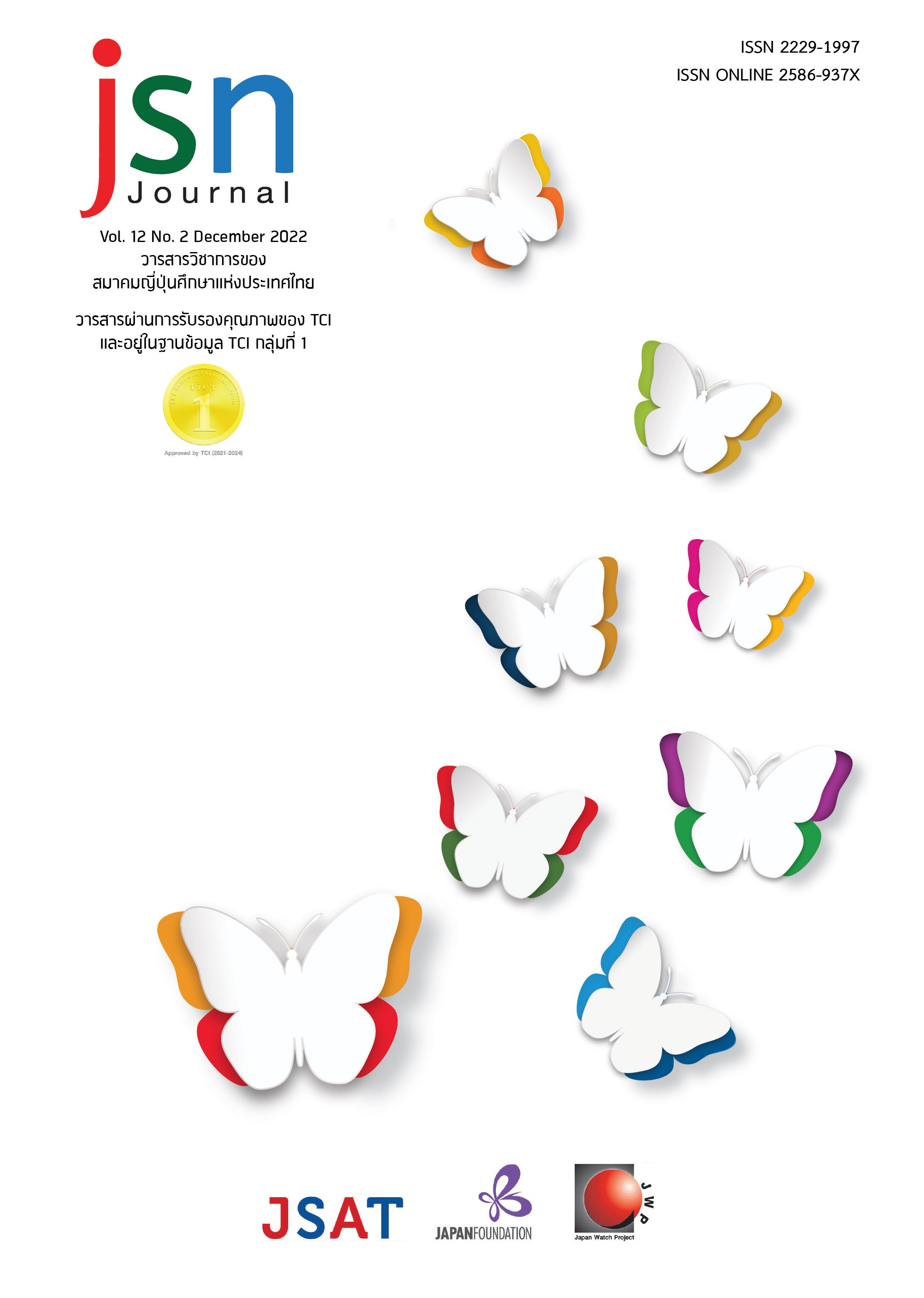On the Difficulty of Elementary Thai Learners of Japanese in Distinguishing Between Intervocalic [k] and [g] Sounds Sound changes in spoken Japanese
Main Article Content
Abstract
The words「信仰(しんこう)」and「信号(しんごう)」are frequently used by Japanese; however, for Thai beginning learners of Japanese, it is difficult to distinguish these words. The author in the present article verified the cause of not being able for them to distinguish these sound problems. According to the survey, it was found that the causes are the following: 1) the way of pronouncing the intervocalic /k/ for Japanese people; and 2) the lack of the /g/ sound in Thai phonology. The Japanese voiceless plosive /k/ has a slight air stream at the initial position. Therefore, the learners recognized it as aspirated ‘ค’. On the other hand, when it is pronounced at the intervocalic position, the air stream is reduced, and the sound is recognized as ‘ก’. In addition, lack of the /g/ in Thai phonology caused mishearing, as well. Thus, the pronounced [g] is recognized as ‘ก’ because of the amount of airflow.
Article Details

This work is licensed under a Creative Commons Attribution-NonCommercial-NoDerivatives 4.0 International License.
ข้อความและข้อคิดเห็นต่างๆ ในบทความเป็นของผู้เขียนบทความนั้นๆ ไม่ใช่ความเห็นของกองบรรณาธิการหรือของวารสาร jsn Journal
References
ประกาศสํานักนายกรัฐมนตรี. (2561). หลักเกณฑ์การทับศัพท์ภาษาเยอรมัน สเปน ญี่ปุ่น และมลายู (69-78 ออักษรศเล่ม135 ตอนพิเศษ 82ง). กรุงเทพฯ : ราชกิจจานุเบกษา.
Crystal, D. (2000). The Cambridge Encyclopedia of Language, second edition. C.U.P.
Maruyama, H. (2021). Why Thai learners of Japanese language misheard ‘nan-ji’ as ‘nan-ji’?: A ออักษรComparative Study of Thai and Japanese Speech Sound. JSN Journal 11 (2), 117-128.
Slayden, G. (2009). Central Thai Phonology. retrieved from http://www.thai-language.com/resources/slayden-thai-phonology.pdf
五十島優. 酒井たか子. 平形裕紀子 (2001).「学習者にとって聞き取りが困難な話し言葉の音変化อักษรศとは」『日本語教育方法研究会誌語』8,26-27.
星野珠美、安田明生 (2002).「日本人学生による中国語有気発話のVOTとパワーによる評価」『日本音響学会誌』11, 689-695.
苅安誠. 太田栄次. SNYDER Steven M. (2007).「日本語と英語・中国語との音声学的特徴と相違点 : 第二言語学習の壁を理解するために」『九州保健福祉大学研究紀要』 8,133-138.
金珠 (2019).「日本語の語頭・語中破裂音のVOTに関する考察 」『日本語・日本文化』46: 47-69.
林嘉恵 (2001).「台湾人日本語学習者が破裂音を聞き取る際の問題点について 」『言語文化と日ออักษร本語教育』21, 140-143.
丸山秀夫 (2008).『発見タイ語発音 : 日本語から学ぶ9つのポイント』. กรุงเทพฯ : สำนักพิมพ์ภาษาและวัฒนธรรม สมาคมส่งเสริมเทคโนโลยี (ไทย-ญี่ปุ่น).
南條健助 (1999).「異音: 音韻論と音声学の接点」『音声研究』3, 20-28.
清水克正 (1993).「閉鎖子音の音声的特徴―有声性・無声性の言語観比較について」Journal of Asian and African Studies. 45,163-175.
清水克正 (2011).「韓国語、タイ語および中国語の話者による日本語閉鎖子音の習得について」『名古屋学院大学論集 言語―文化篇』23(1), 1-13.
清水克正 (2012).「タイ語話者による第3外国語学習におけるVOTに関する考察」『名古屋学ออักษรศ院大学論集 言語―文化篇』24(1), 61-72.
清水克正 (2018).「閉鎖子音の有声性・無声性の音声的特徴に関する考察」『音声研究』ออักษรศ 22(2),69-80.
吉廣綾子(2004).「日本語の無声子音・有声子音、中国語の有気音・無気音の比較」『徳島大学ออักษรศ国語国文学』17,1-13.


